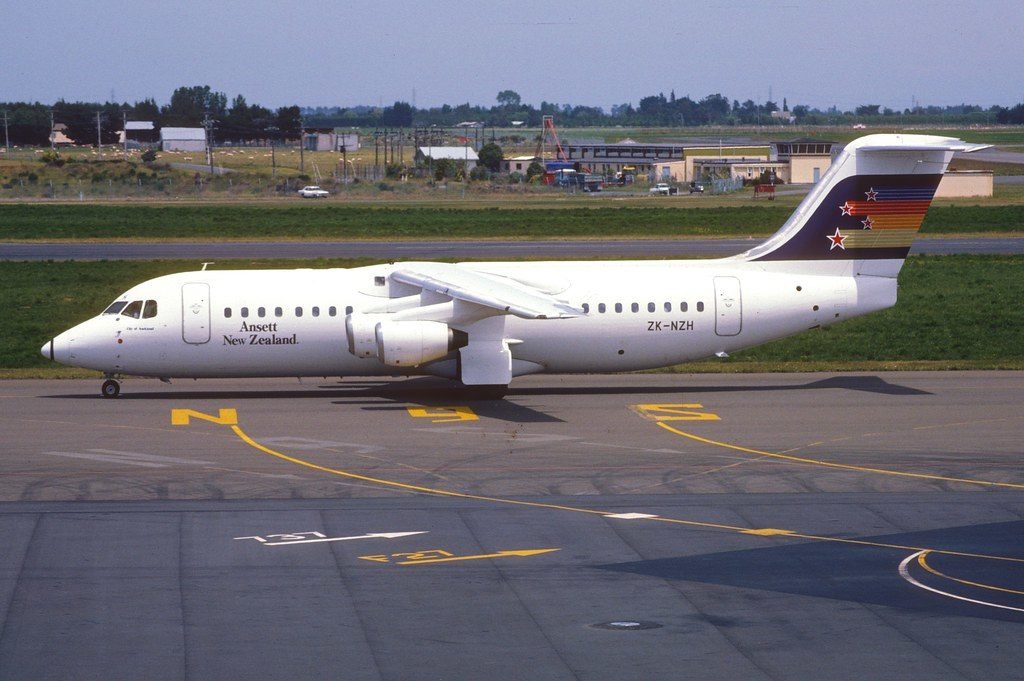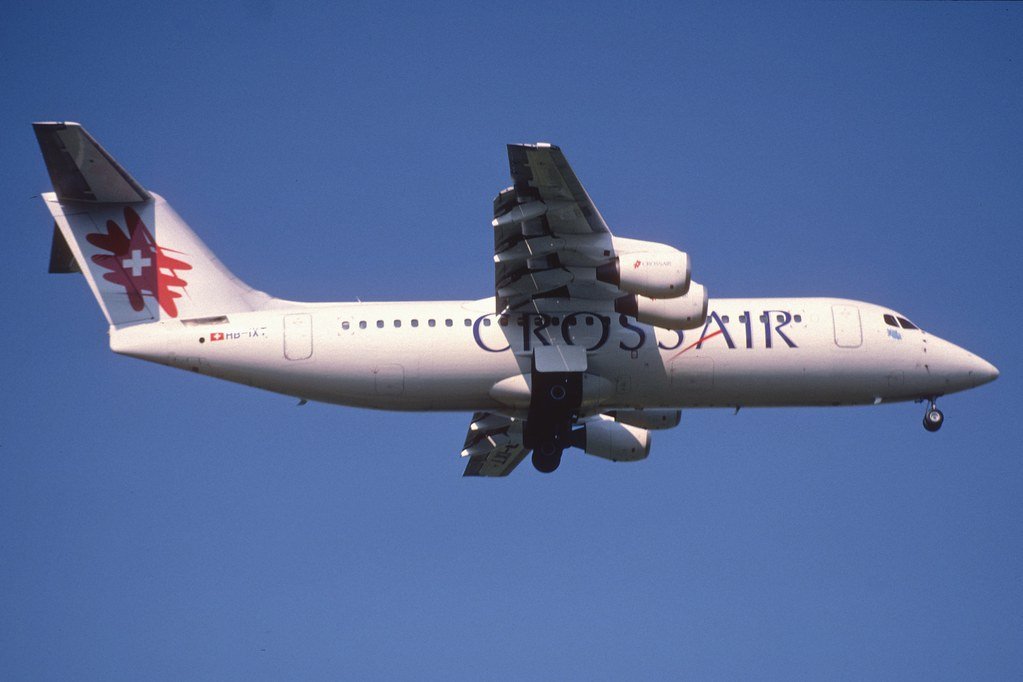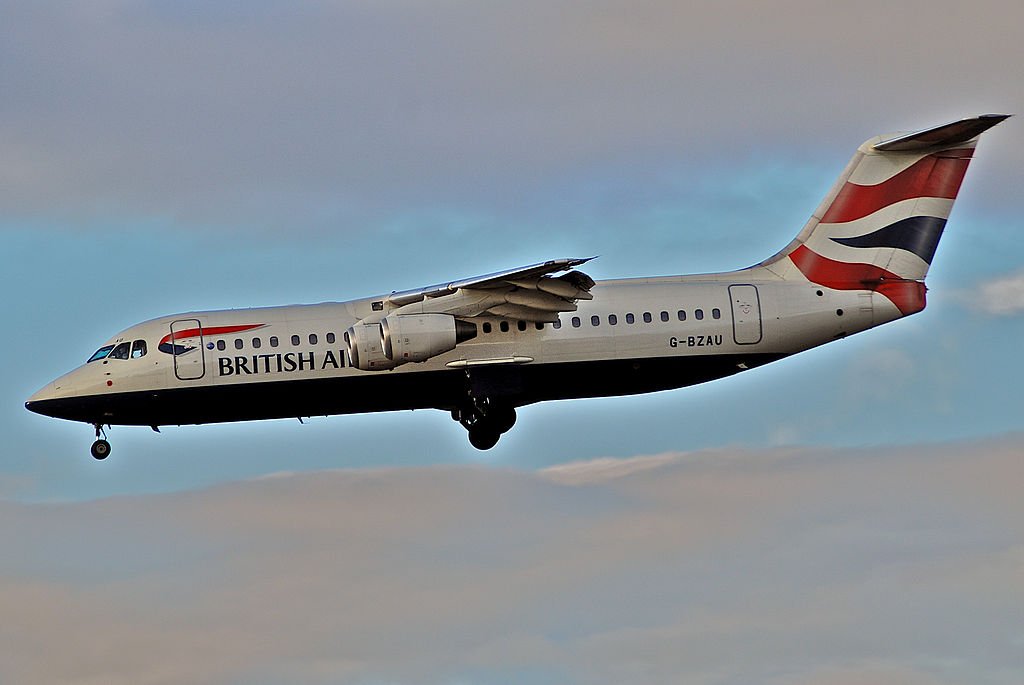
BAe 146 / Avro RJ Whisperjet
ASSEMBLY
HISTORY
SPECS
BAE 146 / RJ 85 CITYJET Reg EI-RJX MSN 2372 landing at Paris Charles de Gaul.
The BAe 146 / Avro RJ is a high cantilever wing, T-tail airliner carrying four jet engines on pylons beneath the main wings. It is arguably Britain's most successful jet program.
BAe 146 had some unusual design characteristics for a jet airliner, but its performance aeronautically and economically cannot be disputed.
The BAe 146 was marketed as a low-maintenance, low operating cost, feeder airliner. Design simplicity was the priority. Many components were off-the-shelf products that could be easily sourced with a minimum of specialised tooling required. This went a long way to keeping the maintenance cost of this airliner down. Using the knowledge gained in the production of the Trident and Airbus A300, the wing was made of as few components as possible. There were no leading edge slats and the top panel of the main wing was a single piece.
BAe Systems Avro 146-RJ85 D-AVRP Lufthansa Regional.
Designed for the regional and short-haul markets, the 146 was manufactured from 1983 until 2002. The aircraft was offered in three variants, 146-100, 146-200, and 146-300. The equivalent Avro variants were RJ70, RJ85, and RJ100. More about that later and see the table at the bottom for more details.
Against predictions, the -200/RJ85 were the best sellers. Each of the variants also came in cargo versions which were denoted by the QT following the variant number, eg. BAe 146-100QT. This stood for Quiet Trader. There was also a QC option which stood for Quick Change. The aircraft would carry passengers during the day, then at night, the modular seats would be removed to enable the carriage of freight. The passenger cabin of the aircraft had a standard configuration of 5 abreast seating, although a high-density 6 abreast configuration was also on offer.
Moving from Hatfield, the Avro RJ series of aircraft were manufactured at BAe Systems Regional Aircraft at Woodford Aerodrome, within the Greater Manchester area. Like most airliners, the Avro RJ parts were manufactured in various locations and brought together for assembly at Woodford Aerodrome. Some of the major parts were sourced as follows:
Rear fuselage – BAe Systems (former Avro) Chadderton.
Centre fuselage – BAe Filton.
Vertical stabiliser- Brough.
Engine pylons – Prestwick.
Nose Section – Hatfield.
Wings – Textron U.S.A.
Control surfaces – Saab-Scania, Sweden.
ASSEMBLY
Ansett New Zealand BAe 146-300 Reg ZK-NZH.
SPECIFICATIONS
The BAe 146 was powered by four Avco Lycoming ALF 502 H engines producing 6,500lbf of thrust each. This configuration was chosen over two engines, as at that time there was no engine on the market producing 13,000lbf of thrust, as well of course due to the redundancy that four engines offer.
The ALF 502 engine was based on the Lycoming T55 turboshaft which was the power behind Chinook heavy-lift helicopters. It was a very quiet engine due to a geared front fan which meant it didn't have to spin as fast keeping the blade tip speed below the sound barrier. Other quietness factors were the high by-pass ratio as well as sound-dampening layers.
Electric power was produced by generators on the two outboard engines which gave easier access for maintenance. Keeping down running and maintenance costs, the engines were modular in construction so that parts could more quickly and easily be replaced.
Air France City Jet Avro RJ 85 Reg EI-RJP at Zurich.
Whilst the ALF 502 engine was a great part of the BAe 146 success story, it did have a few issues. There were cases of internal electronics overheating in flight which resulted in an engine shutdown. This could not be remedied in flight with a restart. There were also cases of engine icing which resulted in reduced power output and challenges with the bleed air system and cabin pressure. In a few cases, irritant fumes were channeled into the passenger cabin.
The BAe 146 was designed to operate to regional destinations with short and rough runways. For this reason, the design favoured a high wing and T-tail. This configuration provided the aircraft with very good short-field operating abilities. The wings and engines were higher off the ground so as to avoid damage from stones thrown up from rougher runways.
The engines did not have reverse thrust for the same reason, as this would cause dust and small stones to be thrown against the aircraft. The braking system of the BAe 146 consisted of the tail section opening like a clam to brake against the airflow. This could also be used in flight to enable a steep descent without speed building up.
On touchdown, the full-length spoilers atop the main wings would deploy to arrest speed and dump lift.
Eurowings BAe 146-300 Reg D-AEWB shows off how the clam speed brakes can be used in flight to reduce speed in descent.
The aircraft configuration was also designed to enable high performance on short runways with a superior climb-out rate, perfect for clearing nearby obstacles.
This also enabled it to perform well at hot and high airfields where lift conditions are poor. When flight testing began, it was found that the aircraft had better takeoff and climb performance than expected. Always a great outcome.
Malmo Aviation BAe RJ100 Reg SE-DSS landing at Manchester
BAe 146 variants top-view silhouettes.
BAe 146 / Avro RJ Specs Table
| British Aerospace/Avro | BAe 146-100/RJ70 | BAe 146-200/RJ85 | BAe 146-300/RJ100 |
|---|---|---|---|
| First Flight | 03 September 1981 | August 1982 | 01 May 1987 |
| Crew | 2 | ||
| Passengers | 70-82 | 85-100 | 97-112 |
| Width(Internal) | 3.42 Metres (11 Feet 2 Inches) | ||
| Aircraft Length | 26.19 Metres (85 Ft 11 In) | 28.55 Metres (93 Ft 8 In) | 31 Metres (102 Ft) |
| Tail Height | 8.61 Metres (28 Feet 2 Inches) | ||
| Main Wing Span | 26.34 Metres (86 Feet 5 Inches) | ||
| Main Wing Area | 77.3 Metres2 (832 Feet2) | ||
| Main Wing Aspect Ratio | 8.98 | ||
| MTOW | 38,101 Kg (84,000 lb) | 42,184 Kg (93,000 lb) | 44,225 Kg (97,500 lb) |
| OEW | 23,820 Kg (52,510 lb) | 24,600 Kg (54,230 lb) | 25,640 Kg (56,530 lb) |
| Maximum Payload | 8,612 Kg (18,990 lb) | 11,233 Kg (24,760 lb) | 11,781 Kg (25,970 lb) |
| Takeoff Dist. | 1,195 M (3,921 ft) | 1,390 M (4,560 ft) | 1,535 M (5,036 ft) |
| Landing Dist. | 1,180 M (3,870 ft) | 1,190 M (3,900 ft) | 1,270 M (4,170 ft) |
| Fuel Capacity | 11,728 Litres (3,098 US Gallons) Longer range option (12,901 Litres (3,408 US Gallons)) | ||
| Engines x 4 | BAe 146: Lycoming ALF 502R-5, Avro RJ: Honeywell LF 507-1F | ||
| Engine Thrust x 4 | 31.1 kN (6,990 lbf) | ||
| Speed (Cruise) | Mach 0.7 (404 kn / 747 km/h) | ||
| Speed (Maximum) | Mach 0.739 (426 kn / 789 km/h) | ||
| Service Ceiling | 35,000 Feet (11,000 Metres) | ||
| Range | 3,870 Km(2,090 nm) | 3,650 Km(1,970 nm) | 3,340 Km(1,800 nm) |
In 1973, British aircraft maker Hawker Siddley launched a project to fill the gap that existed in the market between the turbo-props such as the Hawker Siddley HS-748 and the Fokker F-27 Friendship and the smaller jets such as the BAC-111 and the Boeing 737. The project was launched with 50% backing from the government with an understanding that the government would take a cut from each aircraft produced.
The oil crisis of 1973 caused a dramatic downturn in air travel. As a result, in October 1974 all work stopped on the project which was shelved until it was picked up again by British Aerospace, the successor to Hawker Siddley, in 1978.
History.
BAe 146-100 Airfast Indonesia Reg PK-OSP.
In June 1981, BAe took their first order for the BAe 146 from Líneas Aéreas Privadas Argentinas. That same year, the assembly line at Hatfield, Hertfordshire swung into action. Originally a de Havilland factory, many of the original 146s were assembled here. On a personal note, I used to commute through Hatfield by motorbike at the time, traversing the 11 roundabouts on the A1. I saw a number of 146s taking off from Hatfield for their test flights, including PSA with the distinctive smile on the nose.
On 08 February 1983, the Certificate of Airworthiness was awarded. The first commercial service of the BAe 146 was flown in May 1983 by Dan-Air, a flight from London Gatwick (LGW) to Berne(BRN), Switzerland. A year later, the first of 20 BAe 146s was delivered to Pacific Southwest Airlines(PSA). In January 1987, the BAe 146 was selected as the launch jet aircraft for London City Airport (LCY). Due to its short-field capabilities and quietness, it was the perfect choice for this task. It was at the time the only conventional jet aircraft that could use this airport.
PSA BAe 146-200A Reg N348PS May 1987 with the distinctive smile under the nose.
After 9 years of production, in 1992 a new and improved version of the BAe 146 was introduced. It was time to modernise and update this popular airliner. The new version would be known as the Avro RJ series with the variants being RJ70, RJ85, and RJ100/RJ115. The improvements included upgrading the engines to the higher thrust LF 507 with redesigned nacelles. In the cockpit, the changes were evident in the moving away from the old analogue instrumentation to new EFIS (Electronic Flight Infomation System) screen displays. This replaced instruments like the ADI (Attitude Director Indicator) and the HSI (Horizontal Situation Indicator) to name a few. The engine control system was also modernised using FADEC (Full Authority Digital Engine (or Electronics) Control). The RJ brought the aircraft into line with newer technologies and ensured the type remained relevant into the new century.
On 23 April 1993, Crossair launched services with the first RJ85.
Crossair Avro RJ100 Reg HB-IXT landing at Zurich.
A further improvement, the RJX was announced in 1997. Two prototypes and one production aircraft were built but the project was shelved in 2001. At the 1984 Farnborough Air Show, BAe announced the -300 which was to be quite a drastic change to the -200. It would be 3.2 Metres (10ft 6in) longer, carry 122 passengers, and have winglets. This was met with very lukewarm interest from the airlines who were more interested in a lower price tag in favour of lowering the seat-mile cost. This is understandable as the aircraft could be flown at little over half full and still make a profit. As the table below shows, a less drastic change was offered in the -300 with a length increase over the -200 of 2.34 Metres (7ft 8in), a passenger capacity of 100, and no new engine or winglets.
In all, 387 BAe 146/Avro RJs were produced with the breakdown being 221 BAe 146s and 166 Avro RJs. The largest operator of the type was Swiss Global Airlines which retired its last RJ100 in August of 2017. As of July 2019, there are still 94 aircraft in active service in the world, that being 30 BAe 146s and 64 Avro RJs. A number of these are fulfilling roles as private jets as well as firefighting roles as water and fire-retardant bombers.
British Airways Avro RJ 100 Reg G-BZAU landing at Zurich.

















